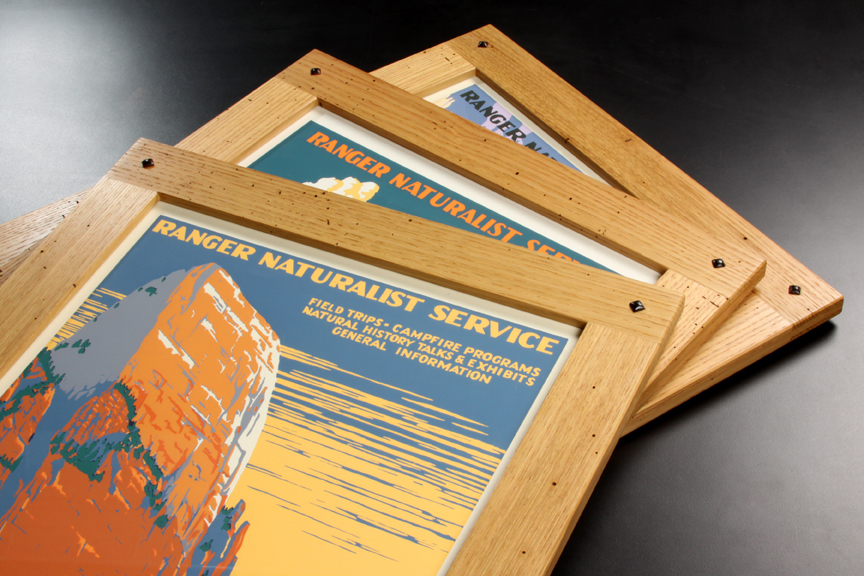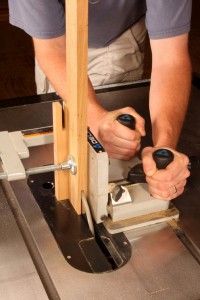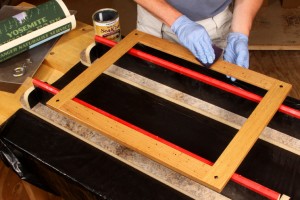 Now that our daughters are old enough to travel well, my family has spent several vacations in our national parks. (Our parks are extraordinary, by the way…well worth the road trip.) As mementos to those visits, we’ve been collecting a series of “woodcut” prints that don’t fit standard sized picture frames. Lately I’ve been building six matching frames to get our collection up on the wall. As you know, there’s a lot of repetitive work that goes on when you’re building a half dozen of anything, so I’ve had some shop time to think about the virtues of picture frames as projects. If you’ve got some artwork squirreled away in the closet or the attic that really belongs on the wall, here’s the shot in the arm you might need to get busy and get it framed:
Now that our daughters are old enough to travel well, my family has spent several vacations in our national parks. (Our parks are extraordinary, by the way…well worth the road trip.) As mementos to those visits, we’ve been collecting a series of “woodcut” prints that don’t fit standard sized picture frames. Lately I’ve been building six matching frames to get our collection up on the wall. As you know, there’s a lot of repetitive work that goes on when you’re building a half dozen of anything, so I’ve had some shop time to think about the virtues of picture frames as projects. If you’ve got some artwork squirreled away in the closet or the attic that really belongs on the wall, here’s the shot in the arm you might need to get busy and get it framed:
1. Custom framing costs a bundle. If you’ve ever paid a framing shop to mount your photos or artwork, you were probably shell-shocked at the price. Convenience and “custom” doesn’t come cheap. I mean no disrespect to those of you out there who may be professional picture framers. Sometimes a professionally matted and framed photo is worth the cost. But, in other cases, it’s sensible to remember that we’re talking about four sticks of wood and a piece of glass here. In the end, the six frames for my park prints have cost me about $75 total. Probably would have cost me more to have even one of these framed in a pro shop.
 2. Scrap bin gold. It doesn’t take much wood to make a picture frame, and I’ll bet you’ve got several different species to choose from in your scrap bin right now. The showier the better. Even if you don’t have long scraps to make a big frame, think small. A 4×6 photo with sentimental value is just as deserving of a nice hand-made frame as something larger.
2. Scrap bin gold. It doesn’t take much wood to make a picture frame, and I’ll bet you’ve got several different species to choose from in your scrap bin right now. The showier the better. Even if you don’t have long scraps to make a big frame, think small. A 4×6 photo with sentimental value is just as deserving of a nice hand-made frame as something larger.
3. Kick your joinery up a notch. Here’s an opportunity to make four perfect joints. You’ll want to build them as well as you can, because they’ll definitely get noticed. A picture frame provides sporting challenge on a small scale. It’s also a great chance to try out joints you haven’t built before or to change up the ones you know already in some new and interesting way. If you go with miter joints, why not add some flair and strength by inserting a contrasting spline? Or, step away from miters completely; I chose open-tenon joints for my frames and pegged them with square ebony pins. Various styles of lap joints or mortise-and-tenons are ideal for framing. Choose the joint style carefully. It will be the signature feature of your project and hopefully what makes the frame fun to build.
 4. Size doesn’t matter. If you check the inventory of store-bought frames, there are maybe a dozen standard sizes or less out there. But as a woodworker, sizing is really a non-issue. You’ve got the ability to build frames in any dimension you need to suit the application. Of course, it doesn’t stop there. You can also create the frame parts as thick or thin, narrow or wide, ornate or plain as you see fit. The creative palette is wide open.
4. Size doesn’t matter. If you check the inventory of store-bought frames, there are maybe a dozen standard sizes or less out there. But as a woodworker, sizing is really a non-issue. You’ve got the ability to build frames in any dimension you need to suit the application. Of course, it doesn’t stop there. You can also create the frame parts as thick or thin, narrow or wide, ornate or plain as you see fit. The creative palette is wide open.
5. Custom for them, quick for you. Hand-made frames make great gifts. Sounds like a commercial, doesn’t it? But really, who wouldn’t love to receive a special photo or piece of art in a custom frame that’s ready for display? The beauty is, here’s a unique and personalized gift that you can churn out, one after the next, once your machine settings are dialed in.
I think you get the picture.
Catch you in the shop,
Chris Marshall, Field Editor






